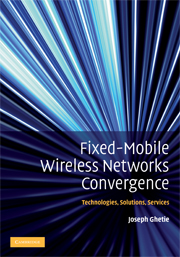Book contents
- Frontmatter
- Contents
- Disclaimer
- How the Book is Organized
- List of Figures
- List of Tables
- Preface
- Acknowledgments
- Acronyms
- Part I Wireless Communications: Networking and Management
- Part II Cellular Mobile Radio Networking and Management
- Part III Fixed Wireless Technologies: Networking and Management
- Part IV Fixed Wireless Cellular Mobile Networks Convergence and Integration
- 10 Fixed-Mobile Convergence Overview
- 11 Wireless LAN Cellular Mobile Convergence
- 12 Wireless PAN Cellular Mobile Convergence
- 13 Wireless MAN Cellular Mobile Convergence
- 14 Wireless Sensor Networks Cellular Mobile Convergence
- Part V Fixed Wireless Cellular Mobile Networks Convergence: Standardized Networking Solutions
- Part VI Fixed-Mobile Convergence Services, Industry Trends, and Implementation Issues
- References
- Index
11 - Wireless LAN Cellular Mobile Convergence
from Part IV - Fixed Wireless Cellular Mobile Networks Convergence and Integration
Published online by Cambridge University Press: 21 August 2009
- Frontmatter
- Contents
- Disclaimer
- How the Book is Organized
- List of Figures
- List of Tables
- Preface
- Acknowledgments
- Acronyms
- Part I Wireless Communications: Networking and Management
- Part II Cellular Mobile Radio Networking and Management
- Part III Fixed Wireless Technologies: Networking and Management
- Part IV Fixed Wireless Cellular Mobile Networks Convergence and Integration
- 10 Fixed-Mobile Convergence Overview
- 11 Wireless LAN Cellular Mobile Convergence
- 12 Wireless PAN Cellular Mobile Convergence
- 13 Wireless MAN Cellular Mobile Convergence
- 14 Wireless Sensor Networks Cellular Mobile Convergence
- Part V Fixed Wireless Cellular Mobile Networks Convergence: Standardized Networking Solutions
- Part VI Fixed-Mobile Convergence Services, Industry Trends, and Implementation Issues
- References
- Index
Summary
WLAN Convergent Network Architecture
In the previous chapter, we defined and described Fixed-Mobile Convergence (FMC) as a multidimensional concept that implies convergence of terminals (cellular handsets and computing devices), networks (NFSN, WPAN, WLAN, WMAN, and cellular mobile WWAN), and applications (data, voice, video, and multimedia). The primary focus of this book is on network convergence. A simplified high-level depiction of FMC at the network level is shown in Figure 11.1.
In this diagram we see that the most compelling convergence/integration cases are between cellular mobile networks and any of the wireless contained networks. The prevalent case, which introduced the notion of FMC to the market, is between WLAN (Wi-Fi) networks and cellular mobile networks. This convergence is attractive because WLANs are included within the wide area coverage of mobile networks but provide higher throughput. Another convergence case is between WPANs and WLANs, where the higher data rate and larger area coverage of WLANs can extend the functionality of WPAN technology such as Bluetooth and Near-Field Sensor Networks such as NFC and RFID. This chapter will focus on convergence between cellular mobile and WLANs.
WLAN Convergent Applications
In Chapter 6 we listed the functionality built into WLAN networks without indicating those applications that are facilitated by convergence of WLAN with other fixed or mobile wired and wireless networks. A short list of WLAN convergent applications follows. Some of these applications will be detailed when we analyze WLAN convergent case studies in subsequent sections of this chapter.
WLAN and cellular mobile convergence (dual-mode handsets and connectivity across cellular mobile networks);
[…]
- Type
- Chapter
- Information
- Fixed-Mobile Wireless Networks ConvergenceTechnologies, Solutions, Services, pp. 220 - 237Publisher: Cambridge University PressPrint publication year: 2008



